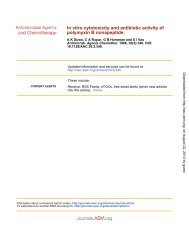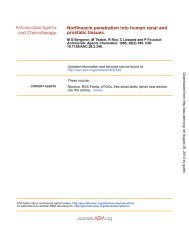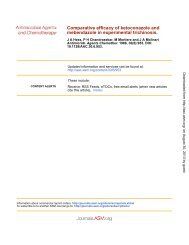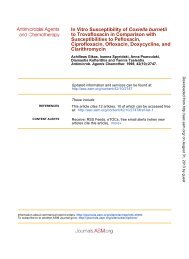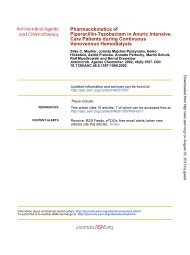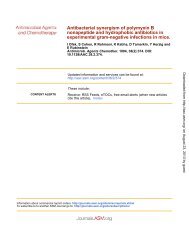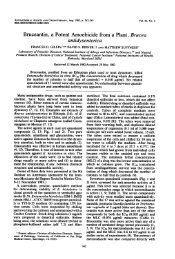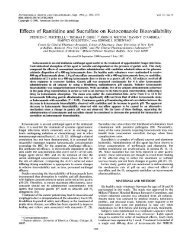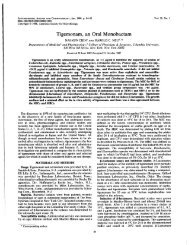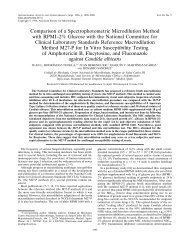Ligands of the Peripheral Benzodiazepine Receptor Are Potent ...
Ligands of the Peripheral Benzodiazepine Receptor Are Potent ...
Ligands of the Peripheral Benzodiazepine Receptor Are Potent ...
You also want an ePaper? Increase the reach of your titles
YUMPU automatically turns print PDFs into web optimized ePapers that Google loves.
REFERENCES<br />
CONTENT ALERTS<br />
<strong>Ligands</strong> <strong>of</strong> <strong>the</strong> <strong>Peripheral</strong> <strong>Benzodiazepine</strong><br />
<strong>Receptor</strong> <strong>Are</strong> <strong>Potent</strong> Inhibitors <strong>of</strong><br />
Plasmodium falciparum and Toxoplasma<br />
gondii In Vitro<br />
Florence Dzierszinski, Alexandra Coppin, Marlene<br />
Mortuaire, Etienne Dewailly, Christian Slomianny,<br />
Jean-Claude Ameisen, Frederic DeBels and Stanislas<br />
Tomavo<br />
Antimicrob. Agents Chemo<strong>the</strong>r. 2002, 46(10):3197. DOI:<br />
10.1128/AAC.46.10.3197-3207.2002.<br />
Updated information and services can be found at:<br />
http://aac.asm.org/content/46/10/3197<br />
These include:<br />
This article cites 29 articles, 12 <strong>of</strong> which can be accessed free<br />
at: http://aac.asm.org/content/46/10/3197#ref-list-1<br />
Receive: RSS Feeds, eTOCs, free email alerts (when new<br />
articles cite this article), more»<br />
Downloaded from http://aac.asm.org/<br />
on August 30, 2013 by guest<br />
Information about commercial reprint orders: http://journals.asm.org/site/misc/reprints.xhtml<br />
To subscribe to to ano<strong>the</strong>r ASM Journal go to: http://journals.asm.org/site/subscriptions/
ANTIMICROBIAL AGENTS AND CHEMOTHERAPY, Oct. 2002, p. 3197–3207 Vol. 46, No. 10<br />
0066-4804/02/$04.000 DOI: 10.1128/AAC.46.10.3197–3207.2002<br />
Copyright © 2002, American Society for Microbiology. All Rights Reserved.<br />
<strong>Ligands</strong> <strong>of</strong> <strong>the</strong> <strong>Peripheral</strong> <strong>Benzodiazepine</strong> <strong>Receptor</strong> <strong>Are</strong><br />
<strong>Potent</strong> Inhibitors <strong>of</strong> Plasmodium falciparum and<br />
Toxoplasma gondii In Vitro<br />
Florence Dzierszinski, 1 † Alexandra Coppin, 1 Marlene Mortuaire, 1 Etienne Dewailly, 2<br />
Christian Slomianny, 2 Jean-Claude Ameisen, 3 Frederic DeBels, 3<br />
and Stanislas Tomavo 1 *<br />
Equipe de Parasitologie Moléculaire, Laboratoire de Chimie Biologique, CNRS UMR 8576, 1 and Laboratoire de<br />
Physiologie Cellulaire, INSERM EPI-9938, 2 Université des Sciences et Technologies de Lille, 59655 Villeneuve<br />
d’Ascq, and EMI-9922 INSERM-Université Paris 7, Groupe Hospitalier Bichat-Claude Bernard, 75877<br />
Paris, 3 France<br />
Received 27 December 2001/Returned for modification 12 March 2002/Accepted 2 July 2002<br />
The increase in resistance <strong>of</strong> <strong>the</strong> malaria parasite Plasmodium falciparum to currently available drugs<br />
demands <strong>the</strong> development <strong>of</strong> new antimalarial agents. In this quest, we have found that ligands to <strong>the</strong><br />
peripheral benzodiazepine receptor such as flurazepam, an agonist <strong>of</strong> <strong>the</strong> benzodiazepine family, and PK11195,<br />
an antagonist derived from isoquinoline, were active against Plasmodium falciparum. These two compounds<br />
effectively and rapidly inhibited parasite growth in vitro, irrespective <strong>of</strong> parasite resistance to chloroquine and<br />
mefloquine. Treatment with both drugs induced a sharp and consistent decline in parasitemia, a complete<br />
inhibition <strong>of</strong> parasite replication, and <strong>the</strong> destruction <strong>of</strong> parasites within <strong>the</strong> host red blood cells. Using<br />
electron microscopy, we showed that dramatic morphological changes, involving swollen endoplasmic reticulum<br />
and <strong>the</strong> reduction <strong>of</strong> hemozoin, were consistent with parasite death. The potent activities <strong>of</strong> flurazepam<br />
and PK11195 were also evaluated for antagonist or synergistic effects with currently used antimalarial drugs<br />
such as chloroquine and mefloquine. Moreover, flurazepam was found to be active against Toxoplasma gondii,<br />
ano<strong>the</strong>r member <strong>of</strong> <strong>the</strong> phylum Apicomplexa. Taken toge<strong>the</strong>r, our results indicated that benzodiazepines could<br />
be considered promising candidates in <strong>the</strong> treatment <strong>of</strong> both malaria and toxoplasmosis.<br />
Among apicomplexan parasites are numerous pathogens<br />
such as Plasmodium species (causative agents <strong>of</strong> malaria), Toxoplasma<br />
gondii (an important opportunistic pathogen associated<br />
with AIDS and congenital birth defects), Eimeria (agent<br />
<strong>of</strong> coccidiosis), and Cryptosporidium (an opportunistic intestinal<br />
pathogen). Malaria is an ancient and intractable vectorborne<br />
infectious disease that has thwarted most efforts to combat<br />
<strong>the</strong> causative agents,Plasmodium spp. Each year, malaria<br />
causes 2 million to 3 million deaths, mostly in children, and<br />
hundreds <strong>of</strong> millions <strong>of</strong> people are debilitated by infection<br />
(27). Infection by T. gondii can lead to severe syndromes including<br />
congenital malformations such as blindness, mental<br />
retardation, and hydrocephaly in children exposed to <strong>the</strong> parasite<br />
in utero. Recently, more attention has been given to T.<br />
gondii because toxoplasmosis is <strong>the</strong> most common cause <strong>of</strong><br />
focal encephalitis or focal central nervous system abnormalities<br />
in immunocompromised patients with AIDS or in transplant<br />
recipients (12, 13). The complex biology and life cycle <strong>of</strong><br />
apicomplexan parasites has hindered attempts to control infections<br />
and prevent transmission. In addition, <strong>the</strong>re is increasing<br />
resistance <strong>of</strong> <strong>the</strong> malaria parasite Plasmodium falciparum<br />
* Corresponding author. Mailing address: Equipe de Parasitologie<br />
Moléculaire, Laboratoire de Chimie Biologique, CNRS UMR 8576,<br />
Bâtiment C9, Université des Sciences et Technologies de Lille, 59655<br />
Villeneuve d’Ascq, France. Phone: 33 3 20 43 69 41. Fax: 33 3 20 43 65<br />
55. E-mail: Stan.Tomavo@univ-lille1.fr.<br />
† Present address: Department <strong>of</strong> Biology, University <strong>of</strong> Pennsylvania,<br />
Philadelphia, PA 19104-6018.<br />
to currently available drugs. As a result, <strong>the</strong>re is an urgent need<br />
for <strong>the</strong> development <strong>of</strong> chemo<strong>the</strong>rapeutic regimens that can<br />
control <strong>the</strong> parasite. Therefore, <strong>the</strong> identification <strong>of</strong> antiparasitic<br />
drugs already in use for o<strong>the</strong>r <strong>the</strong>rapeutic purposes represents<br />
an attractive approach with potentially rapid clinical or<br />
prospective application.<br />
<strong>Benzodiazepine</strong>s (BDZ) are best known for <strong>the</strong>ir action as<br />
anxiolytics, anticonvulsants, antispasmodics, and hypnotics,<br />
leading to <strong>the</strong>ir widespread clinical use. Their physiological<br />
effects are mediated by <strong>the</strong>ir binding to two types <strong>of</strong> receptors<br />
named <strong>the</strong> central BDZ receptor (CBR), which is associated<br />
with <strong>the</strong> GABA A receptor <strong>of</strong> <strong>the</strong> central nervous system, and<br />
<strong>the</strong> peripheral BDZ receptor (PBR), localized in <strong>the</strong> outer<br />
membrane <strong>of</strong> <strong>the</strong> mitochondrion in peripheral cells such as<br />
hemopoietic cells (5, 11). The pharmacology <strong>of</strong> <strong>the</strong> CBR associated<br />
with <strong>the</strong> GABA A receptor complex and <strong>the</strong> PBR was<br />
extensively probed using diazepam, clonazepam, flurazepam,<br />
or PK11195, an antagonist derived from isoquinoline. Although<br />
extensively characterized pharmacologically and biochemically<br />
and implicated in numerous biological processes,<br />
<strong>the</strong> precise function <strong>of</strong> <strong>the</strong> PBR remains an enigma (6). For<br />
example, possible roles <strong>of</strong> <strong>the</strong> PBR in cell proliferation, calcium<br />
channel activity, immune responses, porphyrin transport<br />
and heme biosyn<strong>the</strong>sis, anion transport, regulation <strong>of</strong> steroid<br />
biosyn<strong>the</strong>sis, and regulation <strong>of</strong> mitochondrial oxidative phosphorylation<br />
have been described (6, 30). There have been<br />
many reports that BDZ affect cell growth, proliferation, and<br />
differentiation in a number <strong>of</strong> cell types. A strongly positive<br />
correlation between inhibition <strong>of</strong> cell proliferation and <strong>the</strong><br />
Downloaded from http://aac.asm.org/ on August 30, 2013 by guest<br />
3197
3198 DZIERSZINSKI ET AL. ANTIMICROB. AGENTS CHEMOTHER.<br />
affinities <strong>of</strong> BDZ for <strong>the</strong> PBR has been described (10). However,<br />
BDZ exhibited nanomolar affinities for PBR on <strong>the</strong>se<br />
cells, whereas micromolar concentrations <strong>of</strong> BDZ were necessary<br />
to elicit <strong>the</strong>se antiproliferative effects (10, 26). In addition,<br />
it has been described that protoporphyrin IX, an endogenous<br />
ligand <strong>of</strong> <strong>the</strong> peripheral BDZ receptor, potentiates induction<br />
<strong>of</strong> <strong>the</strong> mitochondrial permeability transition and <strong>the</strong> killing <strong>of</strong><br />
cultured hepatocytes (19).<br />
The PBR is an 18-kDa protein that displays a strong homology<br />
to <strong>the</strong> CrtK/TspO protein <strong>of</strong> <strong>the</strong> outer membrane <strong>of</strong><br />
Rhodobacter sphaeroides and R. capsulatus (2). When expressed<br />
in R. sphaeroides, <strong>the</strong> 18-kDa protein was shown to<br />
bind to BDZ, leading to an alteration in <strong>the</strong> photosyn<strong>the</strong>tic<br />
apparatus (diminution <strong>of</strong> <strong>the</strong> B800-B850 complex) and to an<br />
orientation <strong>of</strong> <strong>the</strong> rhodobacteria toward aerobic metabolism<br />
(28, 29). Given <strong>the</strong>se considerations, especially <strong>the</strong> potential<br />
cytotoxic properties <strong>of</strong> PBR ligands, we aimed to investigate<br />
whe<strong>the</strong>r some <strong>of</strong> <strong>the</strong>se compounds may exert an antiparasitic<br />
activity on P. falciparum and T. gondii. Our rationale was that<br />
as members <strong>of</strong> <strong>the</strong> apicomplexan phylum, <strong>the</strong>se parasites,<br />
which possess both an apicoplast and a mitochondrion, might<br />
be sensitive to PBR ligands. Our results indicate that flurazepam,<br />
an agonist <strong>of</strong> BDZ receptors, and <strong>the</strong> specific PBR<br />
antagonist PK11195 have pr<strong>of</strong>ound deleterious effects on P.<br />
falciparum and T. gondii growth, suggesting that <strong>the</strong>se molecules<br />
might be <strong>of</strong> potential value alone or in combination with<br />
o<strong>the</strong>r antimalarial or anti-Toxoplasma drugs.<br />
MATERIALS AND METHODS<br />
Antimicrobial agents. The following antimicrobial agents were used: chloroquine,<br />
flurazepam (Fz), 1-(2-chlorophenyl)-N-methyl-N-(1-methylpropyl)-3-isoquinoline-carboxamide<br />
(PK11195) (Sigma Chemical Co., St Louis, Mo.) and<br />
mefloquine (a kind gift <strong>of</strong> D. Dive, Pasteur Institute <strong>of</strong> Lille, Lille, France).<br />
PK11195 was dissolved in dimethyl sulfoxide (DMSO) at a concentration <strong>of</strong> 3.3<br />
mg/ml. Fz was dissolved in Dulbecco modified Eagle medium (DMEM) (Biowhittaker)<br />
supplemented with 10% heat-inactivated fetal calf serum (FCS) (Dutscher),<br />
2 mM glutamine (Sigma), and 0.05 mg <strong>of</strong> gentamicin (Sigma) per ml, at<br />
a concentration <strong>of</strong> 5 mg/ml. The same culture medium (DMEM-FCS) described<br />
above was used to culture intracellular tachyzoites <strong>of</strong> T. gondii. Chloroquine and<br />
mefloquine were dissolved in 70% methanol at 5 mg/ml. DMEM-FCS or RPMI<br />
1640-FCS (Gibco BRL) containing DMSO and methanol necessary to dissolve<br />
<strong>the</strong> drugs tested were shown to have no effect on T. gondii and P. falciparum<br />
growth and morphology.<br />
In vitro culture <strong>of</strong> P. falciparum and drug assays. The experiments were<br />
performed with two tissue culture-adapted strains <strong>of</strong> P. falciparum: <strong>the</strong> chloroquine-sensitive<br />
strain HB3 and <strong>the</strong> mefloquino-chloroquine resistant strain Dd2.<br />
The parasites were maintained on human type O erythrocytes in RPMI 1640<br />
culture medium supplemented with 27.5 mM NaHCO 3 , 20 mM HEPES (pH<br />
7.4), 11 mM glucose, and 7.5% (vol/vol) heat-inactivated human AB serum<br />
under 5% CO 2 –5% O 2 –90% N 2 at 37°C (25). The assays were conducted in<br />
96-well plates. The different drug concentrations prepared as described above<br />
were added to asynchronous or synchronous parasite cultures (0.5% parasitemia<br />
and 1.8% hematocrit) in <strong>the</strong> presence <strong>of</strong> 0.5 Ci <strong>of</strong> [ 3 H]hypoxanthine (Amersham;<br />
1 mCi/ml) per well. After incubation for 48 h at 37°C, <strong>the</strong> cells were<br />
harvested from each well with an automatic cell harvester (1450 Microbeta;<br />
Wallac) onto fiberglass filters. The radioactivity was measured by scintillation<br />
counting <strong>of</strong> dried filters. All drug concentrations were tested three times in<br />
triplicate for each experiment. At least three independent experiments were<br />
performed for all drugs tested. Inhibition <strong>of</strong> parasite growth was determined for<br />
each concentration by comparing <strong>the</strong> radioactivity incorporated in <strong>the</strong> treated<br />
cultures with those in <strong>the</strong> control cultures (without drug) maintained on <strong>the</strong> same<br />
plate. The concentrations corresponding to 50% inhibition (IC 50 ) were determined<br />
graphically.<br />
In vitro culture <strong>of</strong> T. gondii and drug assays. Tachyzoites <strong>of</strong> 76K strain <strong>of</strong> T.<br />
gondii were grown in human foreskin fibroblasts (HFF) in DMEM-FCS. The<br />
assays were conducted in 24-well plates. The monolayer <strong>of</strong> HFF cells was infected<br />
with 2 10 5 parasites per well, and 4 to 6 h later, drugs were added at <strong>the</strong><br />
range <strong>of</strong> concentrations described above, alone or in combination. After a fur<strong>the</strong>r<br />
48 h, <strong>the</strong> intracellular tachyzoites were pulse-labeled with 2Ci <strong>of</strong> [ 3 H]uracil<br />
(Amersham) per well for 6 h. The lack <strong>of</strong> uracil phosphoribosyltransferase in <strong>the</strong><br />
host cells allows <strong>the</strong> specific labeling <strong>of</strong> T. gondii (20). After labeling, lysis was<br />
performed in <strong>the</strong> wells using 1% sodium dodecyl sulfate–100 g <strong>of</strong> uracil per ml.<br />
Radiolabeled nucleic acids were precipitated with trichloroacetic acid overnight<br />
at 4°C and <strong>the</strong>n recovered on fiberglass filters. Radioactivity was measured by<br />
scintillation counting (14). All drugs were tested in triplicate for each experiment,<br />
which was repeated three times.<br />
In vitro culture <strong>of</strong> P. falciparum for morphologigal assessment and hemozoin<br />
production. Two 150-cm 2 flasks containing 6% hematocrit and 0.5% parasitemia<br />
were mock treated or treated with 50 g <strong>of</strong> <strong>of</strong> Fz per ml and cultured at 37°C as<br />
described above. The culture medium was changed and <strong>the</strong> drug was replenished<br />
daily. After 72 h, both mock- and drug-treated cultures were diluted to a hemotocrit<br />
<strong>of</strong> 3% in two new flasks and cultured as described for <strong>the</strong> standard growth<br />
conditions with or without <strong>the</strong> drug. The medium was changed twice daily for<br />
both <strong>the</strong> mock- and drug-treated flasks for 72 h until <strong>the</strong> parasitemia reached<br />
16% in <strong>the</strong> mock-treated flask while that <strong>of</strong> <strong>the</strong> Fz-treated culture was reduced<br />
to 0.5%. Samples were <strong>the</strong>n processed for morphological assessment and hemozoin<br />
measurements.<br />
Assessment <strong>of</strong> P. falciparum and T. gondii morphology, development, and<br />
replication. Morphology, development, and replication <strong>of</strong> asynchronous or synchronous<br />
cultures <strong>of</strong> P. falciparum were evaluated in cultures by light microscopy<br />
<strong>of</strong> Giemsa-stained thin blood smears. Smears from drug-free cultures were used<br />
as controls. Parasitemia was measured by counting 1,000 erythrocytes and reported<br />
as <strong>the</strong> percentage <strong>of</strong> total parasitized erythrocytes. Morphologically normal<br />
and abnormal parasites were included in <strong>the</strong> measurements. Parasite proliferation<br />
was based on difference in <strong>the</strong> level <strong>of</strong> parasitemia, and parasite<br />
development within <strong>the</strong> erythrocyte was evaluated by examining <strong>the</strong> number <strong>of</strong><br />
<strong>the</strong> various developmental stages: rings, trophozoites, and schizonts.<br />
For transmission electron microscopy, tachyzoites <strong>of</strong> T. gondii (76K strain)<br />
grown in HFF, or in erythrocytes infected by P. falciparum (HB3 strain) were<br />
treated with Fz or PK11195 for 2 days. The treated intracellular parasites were<br />
fixed in 2.5% glutaraldehyde prepared in 0.1M cacodylate buffer (pH 7.3) and<br />
postfixed in 1% OsO 4 in <strong>the</strong> same buffer. After ethanol dehydration, <strong>the</strong> pellet<br />
was embedded in Epon. Thin sections were cut using a Reichert Ultracut E<br />
ultramicrotome and collected on 100-mesh grids. After being stained with 2%<br />
uranyl acetate prepared in 50% ethanol and lead citrate, sections were observed<br />
in a Hitachi H-600 electron microscope.<br />
Isolation and measurement <strong>of</strong> hemozoin in mock-treated and drug-treated P.<br />
falciparum. The parasites, treated as described above, were collected, washed<br />
with phosphate-buffered saline and harvested by saponin lysis. After PBS washing,<br />
a crude extract <strong>of</strong> hemozoin was prepared by <strong>the</strong> method described by Slater<br />
et al. (22). Briefly, <strong>the</strong> saponin-treated parasites were resuspended in buffer A<br />
(Tris.HCl [pH 7.4]), sonicated for 15 min, and centrifuged at 25,000 g at 4°C<br />
for 30 min. To solubilize any contaminating membranes, crude hemozoin was<br />
extracted twice for 2hatroom temperature in buffer A containing 2% sodium<br />
dodecyl sulfate. The hemozoin pellet was washed three times in buffer A, and<br />
residual proteins were removed by an overnight digestion in buffer A containing<br />
proteinase K at 1 mg/ml. Insoluble material was recovered and washed as described<br />
above before being extracted in 6 M urea for 3hat4°C. The purified<br />
hemozoin was pelleted by centrifugation, and washed with distilled water. Onefourth<br />
<strong>of</strong> <strong>the</strong> hemozoin was solubilized by DMSO and analyzed by matrixassisted<br />
laser desorption mass spectroscopy (MALDI-MS) on a Vision 2000<br />
time-<strong>of</strong>-flight (TOF) instrument (Finnigan Mat, Bremen, Germany) equipped<br />
with a 337-nm UV laser. The remaining hemozoin was solubilized with 0.1 M<br />
NaOH, and <strong>the</strong> UV-visible absorbance spectrum was determined.<br />
Statistics. The significance <strong>of</strong> differences was evaluated by statistical significance<br />
using Student’s t test. P 0.05 was considered significant.<br />
RESULTS<br />
Fz and PK11195 inhibit P. falciparum growth in vitro. In <strong>the</strong><br />
course <strong>of</strong> <strong>the</strong> investigation <strong>of</strong> <strong>the</strong> effects <strong>of</strong> PBR ligands such as<br />
BDZ on <strong>the</strong> growth <strong>of</strong> P. falciparum and T. gondii, we used Fz<br />
(Fig. 1A) and <strong>the</strong> isoquinoline carboxamide (PK11195) (Fig.<br />
1B). Parasite growth was assessed in HB3 strain <strong>of</strong> P. falciparum<br />
by measuring <strong>the</strong> incorporation <strong>of</strong> [ 3 H]hypoxanthine in<br />
growing asynchronous culture. Both Fz and PK11195 inhibited<br />
<strong>the</strong> radiolabel incorporation by <strong>the</strong> parasite in a dose-depen-<br />
Downloaded from http://aac.asm.org/ on August 30, 2013 by guest
VOL. 46, 2002 BENZODIAZEPINE INHIBITION OF PARASITE GROWTH 3199<br />
FIG. 1. Chemical structures <strong>of</strong> <strong>the</strong> two archetypic PBR ligands. (A) Fz. (B) PK11195.<br />
dent manner, allowing <strong>the</strong> calculation <strong>of</strong> <strong>the</strong>ir IC 50 , estimated<br />
at 40 and 20 g/ml, respectively (Fig. 2). When <strong>the</strong> two drugs<br />
were tested at a range <strong>of</strong> concentrations below 10 g/ml, no<br />
significant difference was noticed between treated and untreated<br />
parasites. A sharp decline in [ 3 H]hypoxanthine incorporation<br />
was observed when a combination <strong>of</strong> Fz and PK11195<br />
was tested (Fig. 2). These data indicated no significant synergy<br />
between Fz and PK11195. However, a cumulative inhibition<br />
was observed, as evidenced by a complete inhibition (98%)<br />
<strong>of</strong> incorporation <strong>of</strong> [ 3 H]hypoxanthine at 50 g <strong>of</strong> each drug per<br />
Downloaded from http://aac.asm.org/<br />
on August 30, 2013 by guest<br />
FIG. 2. Inhibitory effect <strong>of</strong> Fz and PK11195 on asynchronous cultures <strong>of</strong> P. falciparum (HB3 strain). Fz was tested alone at doses <strong>of</strong> 0, 10, 20,<br />
25, 30, 35, 40, 45, 50, and 100 g/ml. PK11195 was tested alone at <strong>the</strong> same doses as indicated above. The combination <strong>of</strong> Fz and PK11195 added<br />
to <strong>the</strong> culture at <strong>the</strong> concentrations from 10 to 100 g/ml actually represent 20 to 200 g <strong>of</strong> total drug per ml. [ 3 H]hypoxanthine and drugs were<br />
added, and <strong>the</strong> labeled parasites were harvested after a 48-h exposure. Incorporation by parasite cultures in <strong>the</strong> absence <strong>of</strong> drug was used as <strong>the</strong><br />
100% values. Error bars represent <strong>the</strong> means and standard deviations <strong>of</strong> triplicate determinations <strong>of</strong> a representative <strong>of</strong> three reproducible<br />
experiments (P 0.05). Where error bars are not seen, <strong>the</strong>y are smaller than <strong>the</strong> symbol.
3200 DZIERSZINSKI ET AL. ANTIMICROB. AGENTS CHEMOTHER.<br />
ml (a total concentration <strong>of</strong> 100 g/ml), whereas, at <strong>the</strong> same<br />
concentration, 10 to 30% <strong>of</strong> radiolabel was still incorporated<br />
by <strong>the</strong> parasites when PK11195 and Fz were used alone.<br />
Fz and PK11195 alter P. falciparum morphology and development.<br />
To determine <strong>the</strong> effect <strong>of</strong> <strong>the</strong> drugs on parasite proliferation,<br />
<strong>the</strong> level <strong>of</strong> parasitemia in treated and untreated<br />
cultures was evaluated in Giemsa-stained smears. After 72 h,<br />
<strong>the</strong> parasitemia <strong>of</strong> mock-treated culture reached 6% while that<br />
<strong>of</strong> <strong>the</strong> drug-treated culture was below 1%. After dilution and<br />
culturing for a fur<strong>the</strong>r 72 h, <strong>the</strong> parasitemia reached 16% in <strong>the</strong><br />
mocked-treated samples while remaining at or below 0.5% in<br />
<strong>the</strong> drug-treated sample. Parasite viability was not discernible<br />
from morphological criteria alone, and so morphologically normal<br />
and abnormal parasites were included in <strong>the</strong> measurements.<br />
Therefore, <strong>the</strong> percentage <strong>of</strong> viable parasites in <strong>the</strong><br />
drug-treated cultures may be lower than that mentioned above.<br />
To study <strong>the</strong> effects on parasite development with in <strong>the</strong> red<br />
cell, asynchronized samples were examined after 48 hours <strong>of</strong><br />
treatment. The pr<strong>of</strong>ound effects <strong>of</strong> Fz on <strong>the</strong> parasite growth<br />
are demonstrated by <strong>the</strong> light micrographs shown in Fig. 3<br />
(compare Fig. 3A and C). While all parasitic stages, rings,<br />
trophozoites, and also schizonts (not seen on <strong>the</strong> fields shown<br />
here) were observed in <strong>the</strong> untreated culture (Fig. 3A and B),<br />
only a few parasitic forms were detected in <strong>the</strong> treated culture<br />
(Fig. 3C and D). The uninfected erythrocytes showed normal<br />
morphology in both treated and untreated cultures (Fig. 3,<br />
white arrows). The deleterious effects <strong>of</strong> Fz on P. falciparum<br />
were confirmed by electron microscopy, which revealed that<br />
<strong>the</strong> few remaining parasites in <strong>the</strong> Fz-treated culture lacked<br />
large food vacuoles containing hemozoin crystals, in contrast<br />
to <strong>the</strong> parasites observed in <strong>the</strong> untreated sample (Fig. 4B to<br />
D). This conclusion is supported by <strong>the</strong> observation that in a<br />
random sample <strong>of</strong> 20 infected cells from <strong>the</strong> treated sample,<br />
none <strong>of</strong> <strong>the</strong> parasites contained hemozoin, in contrast to <strong>the</strong><br />
control sample, where <strong>the</strong> majority <strong>of</strong> parasites contained hemozoin<br />
(Fig. 4A). Fur<strong>the</strong>rmore, swollen endoplasmic reticulum<br />
was also evident (Fig. 4C). These pr<strong>of</strong>ound morphological<br />
changes can lead to degeneration and complete destruction <strong>of</strong><br />
parasites within a single asexual cycle (Fig. 4D). The morphology<br />
<strong>of</strong> P. falciparum was also pr<strong>of</strong>oundly altered by PK11195.<br />
A similar pattern <strong>of</strong> degeneration and <strong>the</strong> presence <strong>of</strong> dead<br />
parasites like that shown in Fig. 4D were observed (data not<br />
shown).<br />
Fz treatment <strong>of</strong> P. falciparum also leads to a decrease <strong>of</strong><br />
hemozoin. To provide more evidence for <strong>the</strong> decrease or absence<br />
<strong>of</strong> hemozoin in treated P. falciparum, hemozoin was<br />
purified from both mock-treated and treated parasites (see<br />
Materials and Methods). The UV-visible absorbance spectrum<br />
<strong>of</strong> a base-solubilized (0.1 M NaOH) suspension <strong>of</strong> purified<br />
material from treated parasites gave no absorbance, while <strong>the</strong><br />
untreated or control parasites revealed absorbance values between<br />
325 and 410 nm, with <strong>the</strong> characteristic P. falciparum<br />
hemozoin peak at 390 nm (Fig. 5A). When one-fourth <strong>of</strong> <strong>the</strong><br />
purified crude extract from <strong>the</strong> untreated parasites was solubilized<br />
with DMSO and analyzed by mass spectrometry, <strong>the</strong><br />
major molecular ion was at m/z 616.1 (Fig. 5B), identical to <strong>the</strong><br />
characteristic molecular ion <strong>of</strong> hemozoin (22). Again, no hemozoin<br />
could be detected in <strong>the</strong> Fz-treated parasites. Taken<br />
toge<strong>the</strong>r, <strong>the</strong>se data demonstrate that <strong>the</strong> amount <strong>of</strong> hemozoin<br />
is considerably reduced when cultures <strong>of</strong> human erythrocytes<br />
infected with P. falciparum are treated with Fz. It is most likely<br />
that <strong>the</strong> reduction in <strong>the</strong> amount <strong>of</strong> reflects <strong>the</strong> decrease in<br />
parasite growth and proliferation in <strong>the</strong> drug-treated cultures.<br />
In o<strong>the</strong>r words, this reduction is probably one <strong>of</strong> multiple<br />
morphological changes observed in <strong>the</strong> drug-treated parasites,<br />
consistent with <strong>the</strong> ultrastructural changes described above.<br />
Combined effects <strong>of</strong> Fz and PK11195 with o<strong>the</strong>r antimalarial<br />
compounds. The combination <strong>of</strong> Fz or PK11195 with chloroquine<br />
against <strong>the</strong> P. falciparum chloroquine-sensitive HB3<br />
strain demonstrated significantly increased inhibition <strong>of</strong><br />
[ 3 H]hypoxanthine incorporation in <strong>the</strong> treated parasites compared<br />
to those incubated with chloroquine alone (Fig. 6A).<br />
Specifically, treatment with 19 ng <strong>of</strong> chloroquine per ml had no<br />
obvious effect on parasite growth while <strong>the</strong> addition <strong>of</strong> 20 g<strong>of</strong><br />
Fz or PK11195 per ml significantly reduced <strong>the</strong> [ 3 H]hypoxanthine<br />
incorporation to 80 to 90% compared to <strong>the</strong> untreated<br />
parasites (Fig. 6A). The same pattern <strong>of</strong> parasite growth inhibition<br />
was observed when <strong>the</strong> data for mefloquine alone were<br />
compared with those obtained with mefloquine combined with<br />
ei<strong>the</strong>r Fz or PK11195 (Fig. 6B). Collectively, <strong>the</strong>se experiments<br />
indicate that nei<strong>the</strong>r Fz nor PK11195 displays antagonistic<br />
effects with chloroquine and mefloquine, two drugs already<br />
used in <strong>the</strong> field against malaria. Ra<strong>the</strong>r, <strong>the</strong> data obtained on<br />
<strong>the</strong> interaction <strong>of</strong> Fz or PK11195 with mefloquine or chloroquine<br />
reveal substantial additive effects depending on drug<br />
concentrations. The inhibitory effect <strong>of</strong> Fz and PK11195 can be<br />
readily seen when applying concentrations <strong>of</strong> chloroquine as<br />
low as 19 to 37 ng/ml. At <strong>the</strong>se concentrations, chloroquine<br />
alone appears to be ineffective under our experimental conditions.<br />
Fz and PK11195 inhibit mefloquine- and chloroquine-resistant<br />
P. falciparum as well. The effects <strong>of</strong> Fz and PK11195 on<br />
<strong>the</strong> mefloquine- and chloroquine-resistant Dd2 strain were<br />
evaluated by measuring <strong>the</strong> incorporation <strong>of</strong> [ 3 H]hypoxanthine<br />
in growing asynchronous parasite culture. When parasites <strong>of</strong><br />
<strong>the</strong> Dd2 strain were incubated with increasing chloroquine<br />
concentrations ranging from 9 to 150 ng/ml, <strong>the</strong> strain incorporated<br />
[ 3 H]hypoxanthine at <strong>the</strong> same level as <strong>the</strong> untreated<br />
parasites, demonstrating that <strong>the</strong> Dd2 strain is fully resistant to<br />
chloroquine, as expected (Fig. 7). In contrast, linear and sharp<br />
decrease <strong>of</strong> [ 3 H]hypoxanthine incorporation was observed<br />
when <strong>the</strong> Dd2 strain was incubated with Fz or PK11195 (Fig.<br />
7). Interestingly, additional inhibition was obtained when Fz<br />
and PK11195 were mixed during <strong>the</strong> assay, suggesting cumulative<br />
damage <strong>of</strong> this mefloquino-chloroquine resistant strain<br />
by <strong>the</strong> two drugs (Fig. 7).<br />
Effect <strong>of</strong> Fz and PK11195 on ano<strong>the</strong>r apicomplexan parasite,<br />
T. gondii. The effects <strong>of</strong> Fz and PK11195 on in vitro growth<br />
<strong>of</strong> T. gondii were investigated. Inhibition <strong>of</strong> <strong>the</strong> growth <strong>of</strong><br />
intracellular tachyzoites <strong>of</strong> T. gondii 76K by Fz was indicated by<br />
a reduction in <strong>the</strong> incorporation <strong>of</strong> [ 3 H]uracil (Fig. 8A). The<br />
IC 50 <strong>of</strong> Fz for T. gondii is estimated at approximately 40 g/ml.<br />
Since Fz is known for its activity on <strong>the</strong> host cell mitochondria,<br />
we evaluated its toxicity on <strong>the</strong> uninfected HFF used as host<br />
cells for T. gondii growth, using [ 3 H]hypoxanthine incorporation<br />
in <strong>the</strong> presence and absence <strong>of</strong> <strong>the</strong> two drugs. No difference<br />
was detected in [ 3 H]hypoxanthine incorporated by<br />
treated and untreated fibroblast cells in <strong>the</strong> presence <strong>of</strong> Fz<br />
(data not shown), suggesting that <strong>the</strong> drug had no detectable<br />
toxicity on <strong>the</strong> host cells. When PK11195 was tested, a 20 to<br />
Downloaded from http://aac.asm.org/ on August 30, 2013 by guest
VOL. 46, 2002 BENZODIAZEPINE INHIBITION OF PARASITE GROWTH 3201<br />
Downloaded from http://aac.asm.org/ on August 30, 2013 by guest<br />
FIG. 3. Morphological appearance <strong>of</strong> P. falciparum cultures (HB3 strain) after a 48-h incubation with Fz. Parasites were tested as asynchronized cultures containing<br />
ring, trophozoite, and schizont stages. Shown is <strong>the</strong> morphology <strong>of</strong> Giemsa-stained thin blood smears from drug-free control cultures (A and B) and cultures incubated<br />
with 50 g <strong>of</strong> Fz per ml (C and D). Note <strong>the</strong> absence <strong>of</strong> detectable alterations <strong>of</strong> <strong>the</strong> host blood cells in <strong>the</strong> drug-treated cultures and <strong>the</strong> reduced parasitemia when<br />
<strong>the</strong> two fields are compared. The views are shown at magnifications <strong>of</strong> 100 and 500. White arrows indicate uninfected erythrocytes, and back arrows show infected<br />
erythrocytes.
3202 DZIERSZINSKI ET AL. ANTIMICROB. AGENTS CHEMOTHER.<br />
Downloaded from http://aac.asm.org/<br />
FIG. 4. Morphological alterations <strong>of</strong> P. falciparum (HB3) cultures using transmission electron microscopy after a 48-h incubation with Fz at 10<br />
g/ml (B and C) or 50 g/ml (D) or without drug (control) (A). Note <strong>the</strong> presence <strong>of</strong> hemozoin (stars) in <strong>the</strong> untreated parasites: two distinct<br />
trophozoites are present in this infected erythrocyte (A). The views also show <strong>the</strong> disorganization <strong>of</strong> <strong>the</strong> endoplasmic reticulum (C; arrow), <strong>the</strong><br />
absence <strong>of</strong> hemozoin (B to D), and total degeneration <strong>of</strong> <strong>the</strong> treated parasites (D).<br />
on August 30, 2013 by guest<br />
30% reduction <strong>of</strong> [ 3 H]hypoxanthine incorporation was observed<br />
in uninfected HFF. Therefore, we were unable to distinguish<br />
between <strong>the</strong> specific activity <strong>of</strong> PK11195 on <strong>the</strong> host<br />
cells and T. gondii. Although <strong>the</strong> Fz activity appears more<br />
conclusive, only a moderate effect was observed (Fig. 8A).<br />
Transmission electron microscopy was used to examine <strong>the</strong><br />
effect <strong>of</strong> Fz on parasite morphology. Treatment by Fz did not<br />
appear to affect <strong>the</strong> ultrastructure <strong>of</strong> <strong>the</strong> parasites. However<br />
<strong>the</strong>re did appear to be an effect on parasite proliferation, with<br />
<strong>the</strong> average number <strong>of</strong> parasites per parasitophorous vacuole<br />
being one-fifth lower in <strong>the</strong> treated sample (Fig. 8C) than in<br />
<strong>the</strong> untreated sample (Fig. 8B). This would be consistent with<br />
a cytostatic effect resulting in a reduction in tachyzoite replication<br />
and development. Again, at least 20 vacuoles were observed,<br />
and no significant morphological changes could be<br />
identified, except for a considerably increased in <strong>the</strong> number <strong>of</strong><br />
phagolysosomes in <strong>the</strong> treated host cells and a reduction in <strong>the</strong><br />
number <strong>of</strong> intracellular parasites in <strong>the</strong> treated culture.<br />
DISCUSSION<br />
This study shows a potent activity <strong>of</strong> ligands <strong>of</strong> PBR, such as<br />
Fz and PK11195, against two obligate intracellular apicomplexan<br />
parasites, P. falciparum and T. gondii, when used as single<br />
agents or in combination with o<strong>the</strong>r antiparasitic drugs. High<br />
drug concentrations are required compared to <strong>the</strong> doses <strong>of</strong><br />
BDZ measured in <strong>the</strong> plasma <strong>of</strong> treated patients. The <strong>the</strong>rapeutic<br />
concentrations vary from 0.001 to 3 g/ml, depending<br />
on <strong>the</strong> BDZ used, with toxic levels ranging from 0.05 to 20<br />
g/ml (15, 23). These concentrations were 0.005 to 0.1 g/ml
VOL. 46, 2002 BENZODIAZEPINE INHIBITION OF PARASITE GROWTH 3203<br />
Downloaded from http://aac.asm.org/ on August 30, 2013 by guest<br />
FIG. 5. (A) Comparison <strong>of</strong> <strong>the</strong> UV-visible absorbance spectrum <strong>of</strong> hemozoin purified from a P. falciparum (HB3 strain) culture treated with<br />
50 g <strong>of</strong> Fz per ml and from <strong>the</strong> drug-free control culture. (B) Analysis <strong>of</strong> <strong>the</strong> purified hemozoin by mass spectrometry showing its characteristic<br />
molecular ion at m/z 616.1. The data confirm <strong>the</strong> complete absence <strong>of</strong> hemozoin in <strong>the</strong> drug-treated parasites.<br />
for <strong>the</strong> <strong>the</strong>rapeutic range <strong>of</strong> Fz and 0.2 to 0.5 g/ml for its toxic<br />
level. However, <strong>the</strong> strong lipophilic properties <strong>of</strong> <strong>the</strong>se drugs<br />
and <strong>the</strong>ir capacities to cross <strong>the</strong> blood-brain barrier and to<br />
distribute in tissues indicate that <strong>the</strong>se compounds could be<br />
very interesting in <strong>the</strong> treatment <strong>of</strong> apicomplexan parasites,<br />
such as P. falciparum and T. gondii, with <strong>the</strong>ir complex life<br />
cycles having parasitic stages also localized in <strong>the</strong> central nervous<br />
system or in <strong>the</strong> liver. It is worth noting that similar high<br />
drug concentrations were needed for <strong>the</strong> inhibition <strong>of</strong><br />
Rhodobacter sphaeroides growth (1, 29). It will be <strong>of</strong> great<br />
relevance to determine whe<strong>the</strong>r <strong>the</strong>se drugs are readily effective<br />
against P. falciparum and T. gondii in vivo. Unfortunately,
Downloaded from http://aac.asm.org/ on August 30, 2013 by guest<br />
FIG. 6. Comparative inhibitory effects <strong>of</strong> chloroquine (CQ) (A) or mefloquine (MQ) (B) alone or combined with Fz or PK11195I. Chloroquine<br />
and mafloquine were tested alone at 0, 9, 19, 37, 75, and 150 ng/ml. The series <strong>of</strong> concentrations <strong>of</strong> chloroquine or mefloquine were combined with<br />
Fz (0 to 100 g/ml) or with PK11195 (0 to 100 g/ml) as described in <strong>the</strong> legend to Fig. 2. The combinations <strong>of</strong> chloroquine or mefloquine with<br />
Fz and PK11195 actually represent, for example, 9 ng <strong>of</strong> chloroquine per ml plus 10 g <strong>of</strong> Fz per ml. [ 3 H]hypoxanthine and drugs tested were<br />
added, and labeled parasites were harvested after a 48-h exposure. Error bars represent <strong>the</strong> means and standard deviations <strong>of</strong> triplicate<br />
determinations <strong>of</strong> a representative <strong>of</strong> three reproducible experiments (P 0.05).<br />
3204
VOL. 46, 2002 BENZODIAZEPINE INHIBITION OF PARASITE GROWTH 3205<br />
FIG. 7. Incorporation <strong>of</strong> [ 3 H]hypoxanthine by <strong>the</strong> chloroquine (CQ)- and mefloquine-resistant P. falciparum Dd2 asynchronous cultures in <strong>the</strong><br />
presence <strong>of</strong> chloroquine, Fz, PK11195, or Fz mixed with PK11195. Chloroquine, Fz and PK11195 were tested alone at <strong>the</strong> doses indicated on <strong>the</strong><br />
x axis. The combination <strong>of</strong> Fz with PK11195 was also tested as described in <strong>the</strong> legend to Fig. 2. Error bars represent <strong>the</strong> means and standard<br />
deviations <strong>of</strong> triplicate determinations <strong>of</strong> a representative <strong>of</strong> three reproducible experiments (P 0.05).<br />
Downloaded from http://aac.asm.org/<br />
our preliminary attempts to test <strong>the</strong> activity <strong>of</strong> <strong>the</strong>se drugs in<br />
vivo on T. gondii failed when mice chronically infected with<br />
encysted bradyzoites or with virulent tachyzoites <strong>of</strong> T. gondii<br />
were used (our unpublished data). Because <strong>the</strong> activity <strong>of</strong> <strong>the</strong>se<br />
drugs on T. gondii in vitro was moderate in comparison with<br />
that on P. falciparum, it remains to be determined if Fz and<br />
PK11195 are more effective in vivo against P. falciparum or<br />
o<strong>the</strong>r Plasmodium spp. We believe that <strong>the</strong> data reported<br />
herein provide at least a foundation for fur<strong>the</strong>r studies to test<br />
<strong>the</strong> efficacy <strong>of</strong> <strong>the</strong>se drugs. At <strong>the</strong> moment, because higher<br />
drug concentrations are required to kill apicomplexans than<br />
<strong>the</strong> concentrations achieved in plasma in patients, <strong>the</strong>se compounds<br />
can only be envisaged as early compounds in <strong>the</strong> process<br />
<strong>of</strong> discovering powerful analogs with a better affinity for<br />
<strong>the</strong> PBR-like receptor. Although some BDZ, including Fz, can<br />
bind to both <strong>the</strong> central-type benzodiazepine (CBR) and <strong>the</strong><br />
PBR receptors, <strong>the</strong> effect <strong>of</strong> PK11195 indicates that a related<br />
PBR-like molecule may be involved in <strong>the</strong> activities <strong>of</strong> <strong>the</strong>se<br />
BDZ in <strong>the</strong>se parasites. In addition, it should be noted that<br />
when we used flumazenil, a specific CBR antagonist, alone or<br />
in combination with flurazepam and PK11195, no activity or no<br />
reversal <strong>of</strong> <strong>the</strong> inhibitory effects could be seen in <strong>the</strong> range <strong>of</strong><br />
concentrations which are not toxic to <strong>the</strong> host cells (our unpublished<br />
results), suggesting that <strong>the</strong> mechanisms by which<br />
<strong>the</strong>se BDZ inhibit parasites are probably different from those<br />
occurring in mammalian cells. Whe<strong>the</strong>r flurazepam and<br />
PK11195 bind to homologues <strong>of</strong> mammalian PBR in P. falciparum<br />
and T. gondii remains to be determined. Unfortunately,<br />
our first attempts to clone a PBR-like receptor gene in T.<br />
gondii by PCR amplification using degenerated primers or to<br />
identify such a gene or cDNA in T. gondii and in P. falciparum<br />
were unsuccessful. Alternatively, <strong>the</strong> PBR-like molecules <strong>of</strong><br />
<strong>the</strong> parasite might be structurally different from mammalian<br />
PBR. We were also unable to identify a PBR-like gene when<br />
we examined <strong>the</strong> almost completed genome sequence <strong>of</strong> P.<br />
falciparum and expressed sequence tags from T. gondii.<br />
It is intriguing that <strong>the</strong> treatment <strong>of</strong> P. falciparum with Fz<br />
leads to <strong>the</strong> complete absence <strong>of</strong> parasitic hemozoin, as demonstrated<br />
by UV-visible absorbance spectrum and mass spectrometry,<br />
suggesting an impairment <strong>of</strong> <strong>the</strong> digestive process.<br />
This drug could also modify or interfere with <strong>the</strong> binding <strong>of</strong> an<br />
endogenous compound, for instance protoporphyrin IX, a molecule<br />
which is part <strong>of</strong> <strong>the</strong> heme metabolism in mammalian cells<br />
and which has been proved to bind PBR (26). Although <strong>the</strong>se<br />
molecular mechanisms have not yet been described for P. falciparum,<br />
it is interesting that heme derivatives are capable <strong>of</strong><br />
lysing malaria parasites and that (Plasmodium) parasite survival<br />
relies on its capability to polymerize and store heme<br />
within <strong>the</strong> parasite digestive vacuole (3, 8, 17). It has been<br />
shown that o<strong>the</strong>r antimalarial compounds may act by inhibition<br />
<strong>of</strong> heme polymerization (7, 9, 21, 24), and it remains possible<br />
that such a process might also implicate a PBR-like molecule.<br />
The absence <strong>of</strong> hemozoin in <strong>the</strong> Fz-treated P. falciparum may<br />
simply reflect a direct consequence <strong>of</strong> parasite death, as seen<br />
on August 30, 2013 by guest
3206 DZIERSZINSKI ET AL. ANTIMICROB. AGENTS CHEMOTHER.<br />
FIG. 8. (A) Effect <strong>of</strong> various concentrations <strong>of</strong> Fz at single doses on <strong>the</strong> intracellular replication <strong>of</strong> tachyzoites <strong>of</strong> T. gondii 76K assessed by <strong>the</strong> incorporation <strong>of</strong> [ 3 H]uracil.<br />
Error bars represent <strong>the</strong> means and standard deviations <strong>of</strong> triplicate determinations <strong>of</strong> a representative <strong>of</strong> three reproducible experiments (P 0.05). (B and C)<br />
Ultrastructural morphology <strong>of</strong> T. gondii 76K cultures by transmission electron microscopy after a 48-h incubation with Fz at 50g/ml (C) or without drug (control) (B). Note<br />
<strong>the</strong> accumulation <strong>of</strong> phagolysosomes in <strong>the</strong> host cell cytoplasm and <strong>the</strong> reduced number <strong>of</strong> tachyzoites in treated intracellular parasites (C, arrow) compared to untreated<br />
intracellular parasites (B).<br />
Downloaded from http://aac.asm.org/ on August 30, 2013 by guest
VOL. 46, 2002 BENZODIAZEPINE INHIBITION OF PARASITE GROWTH 3207<br />
by <strong>the</strong> degeneration <strong>of</strong> many parasitic organelles including <strong>the</strong><br />
endoplasmic reticulum. These BDZ also inhibit T. gondii,<br />
which does not syn<strong>the</strong>size any hemozoin, suggesting that no<br />
direct link can be made between a specific inhibition <strong>of</strong> heme<br />
polymerization and <strong>the</strong> Fz activities in <strong>the</strong> parasite.<br />
In conclusion, our preliminary data suggest that Fz and<br />
PK11195 are potentially effective in relatively short-term treatments<br />
<strong>of</strong> P. falciparum because <strong>of</strong> <strong>the</strong> total disappearance <strong>of</strong><br />
parasites and disintegration <strong>of</strong> P. falciparum after 24 to 48 h <strong>of</strong><br />
exposure. As discussed above, this effect can only be moderately<br />
measured for T. gondii. The fact that Fz and PK11195 do<br />
not antagonize <strong>the</strong> o<strong>the</strong>r antimalarial drugs indicated that <strong>the</strong>y<br />
can be combined with chloroquine and/or mefloquine. Most<br />
importantly, it appears that both Fz and PK11195 are effective<br />
against <strong>the</strong> chloroquine- and mefloquine-resistant Dd2 strain<br />
<strong>of</strong> P. falciparum. In <strong>the</strong> quest to identify new antiparasitic<br />
molecules, many compounds derived from isoquinoline have<br />
already been isolated from plants for <strong>the</strong>ir antiplasmodial activity<br />
(4, 16). However, <strong>the</strong> receptors <strong>of</strong> <strong>the</strong>se inhibitors have<br />
not been precisely identified and characterized. Our current<br />
work may also shed new light on <strong>the</strong> molecular and pharmacological<br />
mechanisms <strong>of</strong> conventional quinoline derivatives.<br />
ACKNOWLEDGMENTS<br />
We thank Michael Kibe, Kim Binderup, and David Ferguson (University<br />
<strong>of</strong> Oxford) for critically reading <strong>the</strong> manuscript. We acknowledge<br />
<strong>the</strong> help <strong>of</strong> Guy Ricard for mass spectrometry and C. Auriault<br />
and A. Delannoye at <strong>the</strong> IBL, Pasteur Institute <strong>of</strong> Lille, for providing<br />
us with <strong>the</strong> radioactive automatic cell 1450 Microbeta harvester used in<br />
this study.<br />
This work was supported by grants to S. Tomavo by <strong>the</strong> Centre<br />
National de la Recherche Scientifique (CNRS) through <strong>the</strong> “Action<br />
Thématique Incitative sur Programme et Equipe” (ATIPE). Florence<br />
Dzierszinski and Alexandra Coppin were supported by <strong>the</strong> ANRS.<br />
Florence Dzierszinski and Alexandra Coppin contributed equally to<br />
this work.<br />
REFERENCES<br />
1. Armstrong, G. A., M. Alberti, F. Leach, and J. E. Hearst. 1989. Nucleotide<br />
sequence, organization, and nature <strong>of</strong> <strong>the</strong> protein products <strong>of</strong> <strong>the</strong> carotenoid<br />
biosyn<strong>the</strong>sis gene cluster <strong>of</strong> Rhodobacter capsulatus. Mol. Gen. Genet. 216:<br />
254–268.<br />
2. Baker, M. E., and D. D. Fanestil. 1991. Mammalian peripheral-type benzodiazepine<br />
receptor is homologous to crtK protein <strong>of</strong> Rhodobacter capsulatus,<br />
a photosyn<strong>the</strong>tic bacterium. Cell 65:721–722.<br />
3. Bendrat, K., B. J. Berger, and A. Cerami. 1995. Haem polymerization in<br />
malaria. Nature 378:138–139.<br />
4. Bringmann, G., M. Ochse, M. Schaffer, R. God, R. Walter, and G. Francois.<br />
1997. N,N-dimethyldioncophyllinium A iodide: syn<strong>the</strong>sis, stereoanalysis and<br />
antimalarial activity <strong>of</strong> <strong>the</strong> first N-quaternary naphthylisoquinolinium salt.<br />
Planta Med. 63:544–547.<br />
5. Canat, X., P. Carayon, M. Bouaboula, D. Cahard, D. Shire, C. Roque, G. Le<br />
Fur, and P. Casellas. 1993. Distribution pr<strong>of</strong>ile and properties <strong>of</strong> peripheraltype<br />
benzodiazepine receptors on human hemopoietic cells. Life Sci. 52:107–<br />
118.<br />
6. Casellas, P., S. Galiegue, and A. S. Basile. 2002. <strong>Peripheral</strong> benzodiazepine<br />
receptors and mitochondrial function. Neurochem. Int. 40:475–486.<br />
7. Chou, A., and C. Fitch. 1993. Control <strong>of</strong> heme polymerase by choroquine and<br />
o<strong>the</strong>r quinoline derivatives. Biochem. Biphys. Res. Commun. 195:422–427.<br />
8. Fitch, C., R. Chevli, H. Banyal, G. Phillips, M. Pfaller, and D. Krogstad.<br />
1982. Lysis <strong>of</strong> Plasmodium falciparum by ferriprotoporphyrin IX and a chloroquine-ferriprotoporphyrin<br />
IX complex. Antimicrob. Agents Chemo<strong>the</strong>r.<br />
21:819–822.<br />
9. Fitch, C., and A. Chou. 1997. Regulation <strong>of</strong> heme polymerizing activity and<br />
<strong>the</strong> antimalarial action <strong>of</strong> chloroquine. Antimicrob. Agents Chemo<strong>the</strong>r. 41:<br />
2461–2465.<br />
10. Gorman, A. M. C., G. B. O’Beirne, C. M. Regan, and D. C. Williams. 1989.<br />
Antiproliferative action <strong>of</strong> benzodiazepines in cultured brain cells is not<br />
mediated through <strong>the</strong> peripheral-type benzodiazepine receptor. J. Neurochem.<br />
53:849–855.<br />
11. Krueger, K. E. 1995. Molecular and functional properties <strong>of</strong> mitochondrial<br />
benzodiazepine receptors. Biochim. Biophys. Acta. 1241:453–470.<br />
12. Luft, B. J., and J. S. Remington. 1988. AIDS commentary. Toxoplasmic<br />
encephalitis. J. Infect. Dis. 157:1–6.<br />
13. Luft, B. J., R. Hafner, A. H. Korzun, C. Leport, D. Antoniskis, E. M. Bosler,<br />
D. D. Bourland, R. Uttamchandani, J. Fuhrer, J. Jacobson, P. Morlat, J.-L.<br />
Vilde, and J. S. Remington. 1993. Toxoplasmic encephalitis in patients with<br />
<strong>the</strong> acquired immunodeficiency syndrome. N. Engl. J. Med. 329:995–1000.<br />
14. McFadden, D. C., S. Tomavo, A. E. Berry, and J. C. Boothroyd. 2000. Qo<br />
domain mutations in cytochrome b <strong>of</strong> atovaquone-resistant Toxoplasma mutants<br />
elucidate <strong>the</strong> mechanism <strong>of</strong> action <strong>of</strong> this hydroxynaphtoquinone. Mol.<br />
Biochem. Parasitol. 108:1–12.<br />
15. Meyer, F. P. 1994. Indicative <strong>the</strong>rapeutic and toxic drug concentrations in<br />
plasma: a tabulation. Int. J. Clin. Pharmacol. Ther. 32:71–81.<br />
16. Neumeyer, J., and K. Weinhardt. 1970. Isoquinolines. I. 3-amino- and 3-fluoroisoquinoline<br />
derivatives as potential antimalarials. J. Med. Chem. 13:613–<br />
619.<br />
17. Orjih, A., H. Banyal, R. Chevli, and C. Fitch. 1981. Hemin lyses malaria<br />
parasites. Science 214:667–669.<br />
18. Pandey, A. V., B. L. Tekwani, R. L. Singh, and V. S. Chauban. 1999. Artemisinin,<br />
an endoperoxide antimalarial, disrupts <strong>the</strong> hemoglobin catabolism<br />
and heme detoxification in malarial parasite. J. Biol. Chem. 274:19383–<br />
19388.<br />
19. Pastorino, J. G., G. Simbula, E. Gilfor, J. B. Hoek, and J. L. Farber. 1994.<br />
Protoporphyrin IX, an endogenous ligand <strong>of</strong> <strong>the</strong> peripheral benzodiazepine<br />
receptor, potentiates induction <strong>of</strong> <strong>the</strong> mitochondrial permeability transition<br />
and <strong>the</strong> killing <strong>of</strong> cultured hepatocytes by rotenone. J. Biol. Chem. 269:<br />
31041–31046.<br />
20. Pfefferkorn, E. R., and L. C. Pfefferkorn. 1977. Specific labeling <strong>of</strong> intracellular<br />
Toxoplasma gondii with uracil. J. Protozool. 24:449–453.<br />
21. Slater, A., and A. Cerami. 1992. Inhibition by chloroquine <strong>of</strong> a novel haem<br />
polymerase enzyme activity in malaria trophozoites. Nature 355:167–169.<br />
22. Slater, A. F. G., W. J. Swiggard, B. R. Orton, W. D. Flitter, D. E. Goldberg,<br />
A. Cerami, and G. B. Henderson. 1991. An iron-carboxylate bond links <strong>the</strong><br />
heme units <strong>of</strong> malaria pigment. Proc. Natl. Acad. Sci. USA 88:325–329.<br />
23. Schulz, M., F. Wischhusen, and A. Schmoldt. 1991. Therapeutische and<br />
toxische Plasmakonzentrationen sowie eliminationshalbwertszeiten gebrauchlicher<br />
Arzneist<strong>of</strong>fe. Anas<strong>the</strong>siol. Intensivmed. Notfallmed. Schmerz<strong>the</strong>r.<br />
26:37–43.<br />
24. Sullivan, D. J., J. H. Matile, R. G. Ridley, and D. E. Goldsberg. 1998. A<br />
common mechanism for blockade <strong>of</strong> heme polymerisation by antimalarial<br />
quinolines. J. Biol. Chem. 273:31103–31107.<br />
25. Trager, W., and J. B. Jensen. 1976. Human malaria parasites in continuous<br />
culture. Science 193:673–675.<br />
26. Verma, A., J. Nye, and S. Snyder. 1987. Porphyrins are endogenous ligands<br />
for <strong>the</strong> mitochondrial (peripheral-type) benzodiazepine receptor. Proc. Natl.<br />
Acad. Sci. USA 84:2256–2260.<br />
27. World Health Organization. 1998. Malaria. Fact sheet 94, World Health<br />
Organization, Geneva, Switzerland.<br />
28. Yeliseev, A. A., and S. Kaplan. 1995. A sensory transducer homologous to <strong>the</strong><br />
mammalian peripheral-type benzodiazepine receptor regulates photosyn<strong>the</strong>tic<br />
membrane complex formation in Rhodobacter sphaeroides 2.4.1.<br />
J. Biol. Chem. 270:21167–21175.<br />
29. Yeliseev, A. A., K. E. Krueger, and S. Kaplan. 1997. A mammalian mitochondrial<br />
drug receptor functions as a bacterial “oxygen” sensor. Proc. Natl.<br />
Acad. Sci. USA 94:5101–5106.<br />
30. Zisterer, D. M., and D. C. Williams. 1997. <strong>Peripheral</strong>-type benzodiazepine<br />
receptors. Gen. Pharmacol. 29:305–314.<br />
Downloaded from http://aac.asm.org/ on August 30, 2013 by guest




